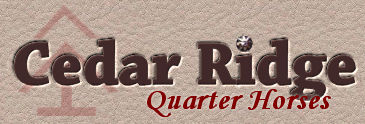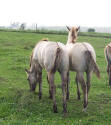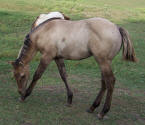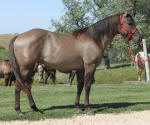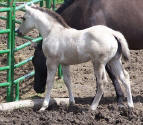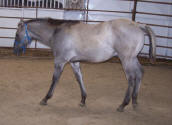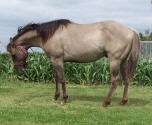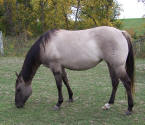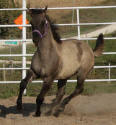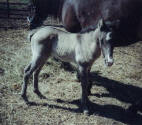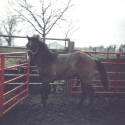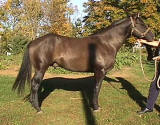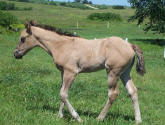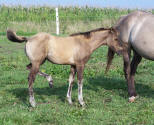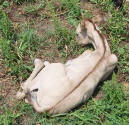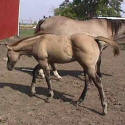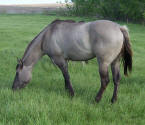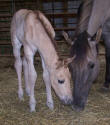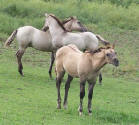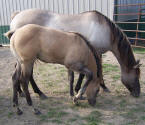

Shades of Grullo
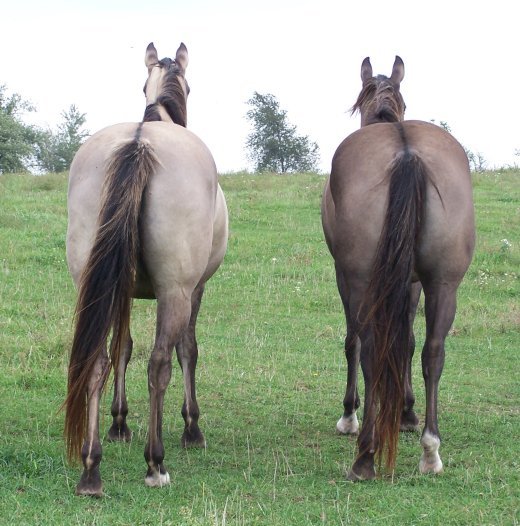
Light slate/silvery grullo (left) and medium slate grullo (right)
|
Unfortunately, there is not a set of swatches (like there is at the paint store) for grullo shades to compare horses to for color description. :-)
In addition, what color a horse "looks" to the eye may not be its correct color, genetically. As you look at this page, remember that it is simply a discussion of the visual appearance of grullos, comparing their levels of lightness/darkness, and attempting to fit those variations into containers that could be widely used to describe a horse, visually. It is similar to palominos, who can vary in shade from very light (isabella) to golden to dark chocolate. Genetically, they are very similar or identical as far as modern genetic tests can tell. Yet their color shades are different, and so they have different labels to help people describe them.
This separation of grullo shades into categories is not the same as categorizing grullos based upon their genetics. It is strictly based upon how they look.
![]()
![]()
![]()
![]()
![]()
Please note that the term "silver" in describing grullo color most often doesn't reflect any inheritance of the "silver" (taffy) gene, as in silver dapple horse colors. The grullo-owning community is trying to break the habit of calling light-colored grullos "silver grullo" now that the taffy gene is called the silver gene.
The term "silver grullo" has been used for years to describe silvery-colored grullos, probably before the silver dapple gene was given its label. However, now that the gene has been accepted with the label of "silver," we all should try to re-teach ourselves to not use the term "silver grulla" for a horse with no silver dapple gene. It may be as simple as adding a "y" to the end, which I'll do here just to avoid the controversy until a better description is agreed upon by those who want to make the rules that the rest of us are to follow. The correct term (as of 2013) for a grullo with a cream gene is "smokey grullo," though not all cream-carrying grullos are silvery in color.
![]()
![]()
![]()
![]()
![]()
Silver* or SilveryIncludes both Silver* and Light Slate These grullos are light enough that most people would call them "silver grullo." Some are true silvers by one popular definition, meaning they have a creme dilution gene (more properly called a smoky grullo). Some are not cream carriers, and are probably better termed "light slate." Regardless, we would not hold it against anyone to call these horses "silver grullo." Well, except for that fact that the definition is changing due to the new term for the taffy gene (silver*). Since grullos change so much from season to season and latitude to latitude (sun fading, rain effects), it is difficult for most people to distinguish between similar shades that are almost identical anyway. Whether they have a creme gene or not, these individuals are silvery to the eye.* Not just blue or lavender, but silver enough to be called "silver." These types of colors (pictured right) don't tend to turn brownish as much as the darker shades do with summer sun. That helps distinguish them from my next major category, below. *It is often said that "silver grullo" is a shade of grullo that comes only with a creme gene. On just about every web site I'd seen and in the few color genetics books I had read prior to about 2001, that was the preferred definition. I personally don't like that definition, because we have had many creme-carrying grullos that were the darker shades and who didn't resemble a silvery cast at all upon visual inspection. As an aside here, the genetically-correct term for a grullo that also carries a cream gene is "Smoky Grullo." |
 Silvery grullo, probable creme gene (smoky grullo)
|
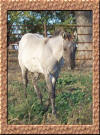
 |
|


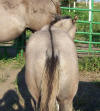 Light slate/silvery grullos with NO creme gene Owned or formerly owned by Cedar Ridge QH's, Iowa USA |
|
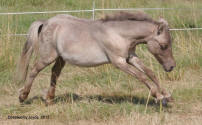 A correctly-labeled "silver grullo," above, with both the Silver Dapple and Dun Factor genes (and he happens to have a cream gene, too!). |
|
|
|
|
Medium SlateMedium Slate is a broad label for the middle shade of grullos. They aren't light and silvery, but they aren't so dark that the dun factor characteristics are difficult to see. Their color may vary from season to season. They may appear blue or dove gray at one time of year, and then they may be very tan-ish or brassy on their bodies at other times of year if the weather causes excessive sun fading. Some of these stay blue/gray throughout the whole year, though. Although these are all what I'd term "medium slate," some are genetically what purists would call "silver grullos" because they carry a creme gene. We feel it is misrepresenting a horse to call a horse a "silver grullo" if it doesn't LOOK silvery, so prefer to label them according to visual examination when talking about shade. It's similar to palomino shades: not all palominos are golden palominos. Some are isabellas and some are chocolate palominos. To call an isabella a golden would be wrong. Similarly, calling a medium slate grullo "silvery" is probably misleading. |
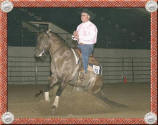
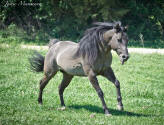 Medium slate grullo, proven creme gene carrier (smoky grullo) Owned by Cedar Ridge QH's, Iowa USA |
 Medium slate grullo, proven creme gene carrier (smoky grullo) Owned by Cedar Ridge QH's, Iowa USA |
|
 Medium slate grullo, proven creme gene carrier (smoky grullo) Formerly owned by Cedar Ridge QH's, Iowa USA |
|
 Medium slate grullo Formerly owned by Cedar Ridge QH's, Iowa USA |
|
 Medium slate grullo Formerly owned by Cedar Ridge QH's, Iowa USA |
|
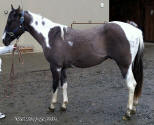 Medium slate grullo color on a Paint |
|
|
|
|
Dark SlateA grullo with or without a creme gene this dark should not be called silver. This one (top cell to right) happens to be a proven creme carrier...and therefore is a true silver grullo according to definition if you believe in the grullo + cream gene = silver equation. But who would term him a silver just by looking at him? We'd say he's beautiful, but we wouldn't call him silver. :-) Another dark slate grullo, Spartacoos. Spartacoos is homozygous for black pigment, like the stallion above him. However, Spartacoos does not carry the creme gene. Note that he is actually a little lighter than the creme-carrying dark slate grullo above him. And also gorgeous! |


 Dark slate grullo, proven creme gene carrier (smoky grullo) Photographed by Cedar Ridge QH's while owned by Balius QH's |
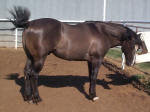 Owned by B4 Ranch, Oklahoma. |
|
So what makes some creme-carrying grullos so dark, and not light silver in shade?
Some say it's the sooty modifier. Regardless, we feel they're too dark to be considered "silver" because it confuses the largest segment of people familiar with grullos, who think silver grullos are light silver in color.
Problems
Defining "Silver Grullo"
There are 3 different definitions that I've seen for "silver grullo," and a problem with these three is that they don't describe the same horses.
-
A silver grullo could be a grullo that also has a cream dilution gene (smoky grullo).
-
A silver grullo could be a grullo that also has a taffy/silver dapple dilution gene.*
-
A silver grullo could be a grullo that is a light or silvery grullo color, as opposed to being a darker shade of grullo.
Which is correct? There are lots of arguments about this.
![]()
![]()
![]()
![]()
![]()
CREAM DILUTION CARRIERS:
Some say that a silver grulla must carry a creme gene. But we have had several creme-carrying grullos that were the darkest shade we've ever had. We would never call them silver grullos even though they were proven creme carriers. See the descriptions in the table above for the differing shades of grullos, including those carrying the creme gene. Note that the darkest grullo pictured is a proven creme gene carrier. I'll also place a couple of cream-carrying grullo pictures here. Would you call all of them silver? By this definition, they are.
Also remember, the genetically-correct term for a grullo that also carries a cream gene is "Smoky Grullo." The term in question (silver grullo) is a layman's description for the shade of grullo (level of lightness or darkness).
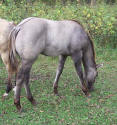





Proof that not all cream-carrying grullos are silvery in color!
![]()
![]()
![]()
![]()
![]()
LIGHT SILVERY BODY COLOR:
Because of the visual incorrectness of the definition of a grullo with a creme gene automatically being a "silver grullo," we just try to call light, non-brownish grullos the silvery grullos. They are generally lacking in sootiness or smuttiness, and so are a clearer blue-silver in color. Some carry creme genes, some don't. But it fits with what the general grullo-knowledgeable population would call "silver," which means that their color appears silvery.
![]()
![]()
![]()
![]()
![]()
TAFFY/SILVER DAPPLE DILUTION CARRIERS:
Now that the taffy/silver dapple gene is being called the "silver gene," some people feel that any color with "silver" in the name should be allowed for ONLY horses carrying a silver dapple/taffy gene. Since this label has been accepted for defining the silver dapple gene, we should try to NOT use "silver grullo" to describe any horse that does not have a silver gene. (oh boy...I need help finding all the places in this web site that were created pre-silver-dapple-controversy to correct my own use of the word "silver!")
I know...it will be hard. For 50 years or more, the lighter, silvery-shade of grullo has been called "silver grulla," and now we're supposed to change. Buck up...we can do it. Old dogs can learn new tricks! :-)

A correctly-labeled "silver grullo," with both the Silver Dapple and Dun
Factor genes (and he happens to have a cream gene, too!).
We welcome donations of pictures of proven silver dapple + grullo horses!
(please make sure you own the copyright to any donated photos)
Click here for information on how you can donate
your silver dapple + grullo photos.
Seasonal Changes In Color Cause Problems
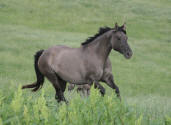

Same horse, but sun faded on right.
Grullos change color from season to season. In the spring, they are less brown and more blue. In the summer, they are more brown and lighter in the body from sun fading. In the fall, they are dark when their fall hair comes in. A grullo whose color is defined in the spring might look a lot different six months later.
Too Many "Labels" for Grullo Shades Cause Problems
-
White grullo
-
Silver grullo
-
Smokey (smoky) grullo
-
Light slate
-
Blue grullo
-
Medium slate
-
Olive grullo
-
Dark slate
-
Lobo dun
-
Mouse dun
-
Black dun
WOW! That is too much. I don't see much reasoning behind all these labels when a horse might fit one label for part of the year, and another during different seasons due to sun fading. So few people know them all that a multitude of labels like that just creates confusion and room for unintentional (or intentional) misrepresentation.
My vote would be to keep it simple with these three
categories:
-
Silvery grullos or Light Slate grullos (the lighter shades)
-
Medium slate grullos (obviously, not light or silvery but not dark)
-
Dark slate grullos...Actually, I'd probably strike this one out, because there aren't very many dark slate grullos. Most are light or medium shades.
![]()
![]()
![]()
![]()
![]()
Can You Predict What Shade of Grullo a Foal will be by Foal Coat Color?
Kind of, but not reliably. This table could help you.
![]()
![]()
![]()
![]()
![]()
Click here to take a grullo color quiz
![]()
![]()
![]()
![]()
![]()
Click here to request help determining your horse or foal's color
![]()
![]()
![]()
![]()
![]()
Photo Ownership Notice:
All of the photos on this page are the property of Cedar Ridge QH's or were
sent to us with permission.
If someone has sent a photo to us for use on our pages that belongs to you,
and if they did not have
permission to do so,
please let us know.
If you are interested in contributing a photo, we thank you! But please do not
alter the photo or place your contact
information on it. Our educational pages are for just that...education. Not
advertisements. Thanks!
|
![]()
![]()
![]()
![]()
![]()
How To Donate Your Educational Photo:
-
If you are wondering what color your foal is, click here. We are having a lot of people send us pictures for this page where it is obvious that the foal owners don't know what color their foal is. Please, only send us photos for this page if you know your foal's color. If you don't know what color your foal is, click here.
-
If you foal is a Paint or Appaloosa, we will only use it if the vast majority of the foal's body is not included in the white patterned areas, as this page is intended to help people determine foal colors, so the colored hairs must be very obvious.
-
This is an educational page, and photos should show a safe environment and healthy horses. I don't even know how to respond when I receive photos of wormy, skinny horses in pastures littered with abandoned cars, farm equipment, wire fences laying on the ground, and falling-down buildings. I simply can't put photos like that on an educational page like this, where people come to learn.
-
Please note that this is not intended to be a free opportunity for you to advertise your breeding operation, and instead is an educational page. We will not use photos with watermarks/writing on them. There are many free advertising sites on the Internet at which you can advertise your farm/ranch/horses. Also, only send photos of foals you own. This way, there won't be copyright problems.

Feel free to click the "Send Your Photo" logo
at the left to send a good photo or two to us for inclusion on our
color pages.
Photo Ownership Notice:
All of the photos on this page are the property of Cedar Ridge QH's or were
sent to us with permission.
If someone has sent a photo to us for use on our pages that belongs to you,
and if they did not have
permission to do so,
please let us know.
If you are interested in contributing a photo, we thank you! But please do not
alter the photo or place your contact
information on it. Our educational pages are for just that...education. Not
advertisements. Thanks!
This page last updated
05/28/21
If you notice this date being 2 years or older, please let
us know that we need to check out this page!
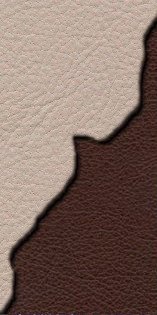
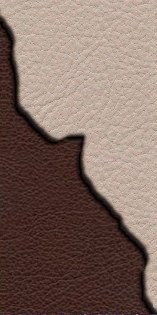
Home Horses For Sale Stallions Mares Foals Blog Color Genetics Riding Horses Site Map Contact Us

Toni Perdew
Bedford, Iowa
toni@grullablue.com
712-370-0851 cell, before 9 p.m. CST
![]()
www.facebook.com/CedarRidgeQuarterHorses
Web design by
CR
Equine Sites.
All rights reserved. Graphics are watermarked for copyright protection.
Terms of Use
